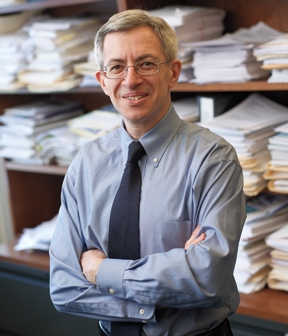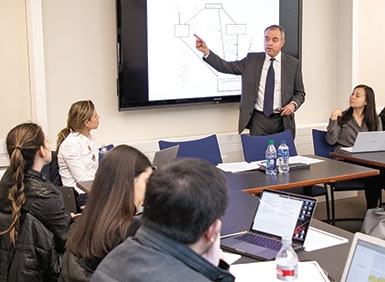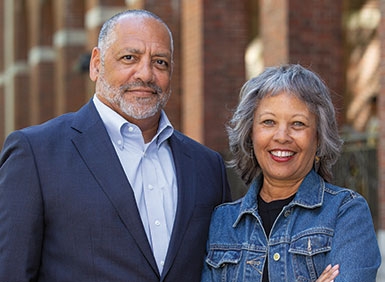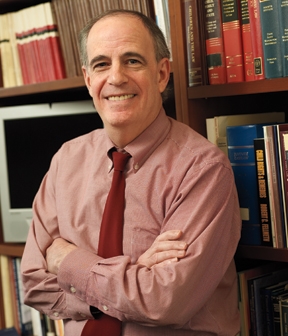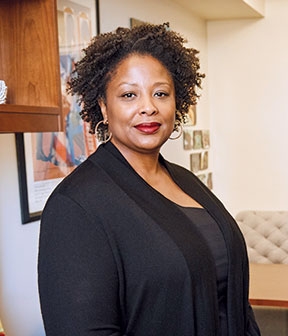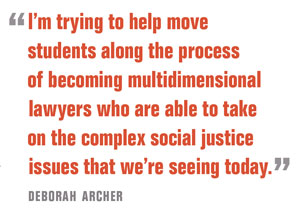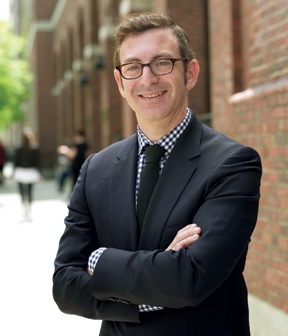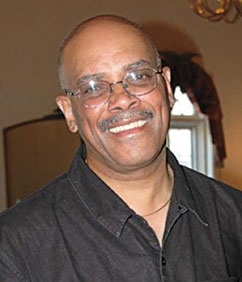Vintage Modern
For nearly 50 years, the clinical law program has evolved and innovated to train students—and address the pressing needs of the day.
BY MICHAEL OREY
ILLUSTRATIONS BY IAN MURRAY
The fifth and sixth floors of Furman Hall, which house the Jacob D. Fuchsberg Clinical Law Center, are usually library-quiet. But on the afternoon of March 8, more than 250 students streamed through the halls, going in and out of offices, helping themselves to the snacks set out in the reception area. “It was packed. There were people everywhere,” recalls Anna Applebaum ’21. “It was not quiet.”
This was the Clinic Fair, an annual event at which clinical faculty along with some of their current students hold information sessions for those like Applebaum, who are shopping for courses for the coming academic year. More than 500 NYU Law students enroll in the nearly 40 clinics and externships available each year. A printout of offerings during the 2019–20 academic year would run 120 pages, which is why getting some in-person guidance can be helpful. Applebaum, who visited four clinics during the fair, will take the Racial Justice Clinic as a 2L.
Professor of Clinical Law Jason Schultz, who teaches the Technology Law and Policy Clinic, compares the Clinic Fair to Halloween. “Students are coming around, and they’re like knock, knock, knock, and it’s that trick-or-treat moment, but the candy you’re giving them is your spiel on clinics or externships.”
“They asked very insightful questions,” says Associate Professor of Clinical Law Deborah Archer of the students who crowded into her office, a dozen or so at a time, to find out more about the Civil Rights Clinic that she teaches. “They’re very thoughtful about how a clinic can fit into their legal education and move them along their journey toward becoming the kind of advocate they want to be.”
That undertaking—integrating practice-oriented legal instruction with traditional, doctrinal offerings— began at NYU Law a half century ago, and the school quickly emerged as a pioneer in clinical legal education. That leadership continues. A hallmark of the clinical program from early on has been its continuous evolution and innovation, including the way the program is organized and its position within the larger Law School environment. Individual clinics develop novel approaches to client representation and broader legal and policy advocacy. And new clinics are regularly added, often in emerging areas of practice.
In 2013, when Dean Trevor Morrison took office, the clinical faculty gave him a statement of guiding principles: “What allows the clinical program to maintain [its] place of distinction is that our mission is unapologetically ambitious. We prepare to transform the ways that individuals and communities experience justice.”
Laying a Foundation
In 1970, the Law School launched its first clinic, with eight students enrolling to represent indigent defendants in state criminal court (the student-faculty ratio remains 8 to 1 in clinics today). Over the subsequent decade, the school added offerings in areas such as federal defense, prosecution, and juvenile rights. The clinics were respected nationally, recalls Frank Bress, who was a clinical professor during the 1970s and 1980s and now directs clinical programs at New York Law School, but each operated “as its own fiefdom,” and there were no gateway classes to ground students in the basics of practice.
That changed in 1981 with the arrival of Anthony Amsterdam, now University Professor Emeritus, who laid the foundation for the clinical law program as it exists today. A prominent civil rights and death penalty-defense attorney, Amsterdam had been a clinical professor at Stanford Law School. Teaching students to “think like a lawyer” has long been a hallmark of doctrinal courses; Amsterdam thought legal education should apply the same kind of conceptual analysis to the way lawyers practice. He designed an integrated clinical curriculum that included the groundbreaking first-year Lawyering course, which not only taught basic skills, such as witness preparation and negotiation, but also encouraged students to assess them critically. Widely emulated at other law schools, Lawyering grew into its own program and became a mandatory full-year course for 1Ls in 1986.
In 1994, Randy Hertz co-founded the Clinical Law Review, the first scholarly journal to focus on clinical legal education. He has served as its editor-in-chief ever since, even as he has become a vice dean and director of clinical and advocacy programs at the Law School— all the while teaching the Juvenile Defender and other clinics. Jane Aiken ’83, who taught clinical and doctrinal courses at Georgetown University Law Center for more than a decade, says Hertz’s support of clinical scholarship “has been transformative in the clinical community.” Deans at other law schools periodically bring him on as a consultant. “He is so well respected,” says Aiken, who was named dean at Wake Forest University School of Law in April, “that his input can make a significant difference in how resources are allocated for clinical programs.”
As the Law School has continued to add new clinical courses, it has also expanded opportunities for experiential training through externships, which combine a weekly seminar with fieldwork, generally at a government or nonprofit organization. Some new offerings have been in traditional areas, such as the Equal Justice and Defender Externship (originally the Capital Defender Clinic) taught by Aronson Family Professor of Criminal Justice Bryan Stevenson in Montgomery, Alabama. Others have pushed in completely new directions, toward transactional practice or global issues, for example. The International Transactions Clinic, directed by Associate Professor of Clinical Law Deborah Burand, combines both these emphases.
Hertz acknowledges that law schools can teach many practice skills with a fairly small number of clinics. NYU Law, he says, has committed itself to a broad range of offerings because “we think it’s more engaging and more fulfilling for students to be able to work in the areas they care about.” Many additions to the clinic curriculum in the last 10 to 15 years were in response to student requests, he says, citing the LGBTQ Rights Externship, the Mediation Clinic, and Archer’s Civil Rights Clinic—a new take on a long-standing offering. (See graphic, below, for an overview of clinical offerings by practice area.)
google.charts.load('current', {'packages':['corechart']}); google.charts.setOnLoadCallback(drawChart); function drawChart() { var data = google.visualization.arrayToDataTable([ ['Task', 'NUMBER OF STUDENT POSITIONS AVAILABLE IN NYU LAW CLINICS, BY PRACTICE AREA'], ['Criminal: Defense', 56], ['Criminal: Prosecution', 50], ['Civil Rights', 58], ['Other Civil Practice', 110], ['Administrative/Regulatory', 49], ['Public Policy', 24], ['Transactional/Business', 44], ['Government Practice (excluding criminal prosecution)', 70], ['Global', 69], ['Law and Technology', 24] ]); var options = { title: 'NUMBER OF STUDENT POSITIONS AVAILABLE IN NYU LAW CLINICS, BY PRACTICE AREA', colors: ['#447080', '#c0293a', '#a4b678', '#7dafa8', '#4c4d61', '#da523d', '#a99263', '#f4bb3d', '#72ab6b', '#787e78'], is3D: true, width: '100%', pieSliceText: 'value', height: '500px' }; var chart = new google.visualization.PieChart(document.getElementById('piechart')); chart.draw(data, options); } $(window).on("throttledresize", function (event) { var options = { width: '100%', height: '100%' }; var data = google.visualization.arrayToDataTable([]); drawChart(data, options); });The multitude of options is an attraction for prospective students and faculty alike. “There are so many clinics here that deal with or touch on issues of racial justice and civil rights work, and that’s particularly what I want to do,” says 2L Applebaum, “so it kind of elevated NYU to being my number-one choice.” The variety of choices, she adds, may also be attractive to students who are less sure which kind of law they want to practice, because it allows them to explore alternatives.
Archer, who is the newest member of the clinical faculty, said she was drawn to NYU Law by both the number of clinics and by the fact that clinics approach advocacy from different angles. “It’s that combination of the ways in which we’re trying to cover the full spectrum of what it means to be a lawyer,” she says.
Criminal Defense and Reentry: Looking beyond the case
From the early 1970s into the 1990s, Hertz says, NYU Law’s core criminal defense clinic was a traditional litigation clinic, focusing exclusively on the skills involved in representing individual clients in criminal cases. But when former public defenders Kim Taylor-Thompson and Anthony Thompson arrived at the Law School as professors of clinical law—he in 1996 and she in 1997—they believed a broader approach was needed, both for representing individual clients and to address larger issues of criminal justice. Two courses they taught, the Community Defender Clinic and the Offender Reentry Clinic, eventually merged to become the Criminal Defense and Reentry Clinic.
The idea behind the Community Defender Clinic was that “defenders really need to think about what it means to represent individuals who come from marginalized communities, understanding that the criminal case may just be the tip of the iceberg,” explains Taylor-Thompson. “You really do have to understand what that person’s life circumstances are, what the community enables them to do, what roadblocks perhaps are set up in that community that keep them from having a set of options. So it was really about changing the orientation from the life of the case to the life of the client.” Students worked on helping local public defender offices become more integrated into their communities, and represented individual clients as well.
In the Offender Reentry Clinic, the focus was on individuals returning from prison to the community. People in this circumstance face obstacles that include not just finding jobs but being barred from educational loans and public housing. Students worked with individual clients to try to resolve these issues. They also worked to advance measures in New York and elsewhere that would facilitate reentry—by protecting employment rights of ex-offenders, for example.
Taylor-Thompson and Thompson co-taught their combined Criminal Defense and Reentry Clinic for the first time in 2014. “We realized that teaching about reentry needed to be woven into the fabric of representation from the beginning and would lead to better outcomes for clients,” Anthony Thompson says. And, using a word that is echoed by other clinical faculty, he says they wanted to teach students to take a “holistic” approach to cases and issues.
Yes, students still need to learn courtroom skills—and that remains a big part of the course—but they also learn to connect to defendants’ communities, to do media advocacy through writing op-ed articles, and to engage in legislative advocacy on criminal justice reform.
“What we realized as we were teaching 21st-century defenders,” Thompson says, “is that we needed to move beyond the model of simply being in criminal court.”
“The Criminal Defense and Reentry Clinic is a perfect example of the ways in which our clinics have developed over the years to refine and enrich the lessons they teach,” says Hertz. And those lessons are spreading. Joshua Saunders ’06, an alum of the clinic who is now a managing attorney in the Seattle public defender’s office, says, “Kim and Tony are widely respected in the public defense community. The community defender model has been widely praised and adopted, at least in part, around the country.”
And with so many graduates of their clinic now in practice, he says, they “are basically the parents of an entire generation and community of public defenders.”
Family Defense: Defending parents to get the best outcome for families
When Fiorello LaGuardia Professor of Clinical Law Martin Guggenheim ’71 launched the Family Defense Clinic to handle child welfare cases in 1990, it was with a revolutionary premise: the clients would be parents accused of mistreating their children. The children in these cases, Guggenheim reasoned, were generally well represented, usually by a legal aid office. Attorneys for parents—who potentially faced having their children taken away via state intervention—frequently did a poor job. The aim, Guggenheim explains, was “to wholly re-imagine the practice of defending parents in child welfare cases.”
The clinic became a laboratory. One early insight grew out of the fact that the cases proceed on two tracks, judicial and administrative. “No good lawyer can afford to ignore the administrative process,” Guggenheim says. Plans to keep or return children to their homes are most often developed and implemented by the agency overseeing the case, so participating in agency conferences and communicating with case workers was critical. While the agency resisted having lawyers do this, it was receptive to social workers performing the role. Ever since the clinic’s third year, each case has been staffed by two law students and one social work student, with instructors from both fields supervising each team.
As data accumulated over time, it became clear that this multidisciplinary approach produced dramatic results, reducing the time children were spending in foster care and returning them to their homes without increased risk to their safety. As Guggenheim explains it, parent defense really functioned as family defense (thus the clinic’s name), because the approach often benefits parents and children alike.
In 2007, New York City began contracting with multiple non-profit law offices, such as Bronx Defenders, to implement the family defense approach. And, says Eliza Patten ’01, “The practice model Marty set out to create has caught hold, spread nationally, and influenced a shift in child welfare policy at the federal level.” A December 2018 rule change by the Children’s Bureau, a federal agency that oversees child welfare policy, will make federal funds available to pay for representation of parents as well as children. According to an April article in the Chronicle of Social Change, the rule revision “augers a sea change in child welfare,” with organizations in New York, California, and Colorado potentially receiving more than $100 million.
Last year, Patten—who says her decision to attend NYU Law “was driven entirely by my desire to participate in the Family Defense Clinic”—and Zabrina Aleguire ’05 co-founded the East Bay Family Defenders in San Leandro, California. In 2016, the State of Colorado established the Office of Respondent Parents’ Counsel, which commissioned a bumper sticker with the quotation, “Every child deserves to have their parent represented by the best attorney in town.” It’s attributed to Guggenheim.
Civil Rights: “Big, complex problems”
Archer’s Civil Rights Clinic has the title of a traditional clinical course long available at many schools, including NYU Law. Except there’s nothing traditional about the way Archer has her students approach civil rights. During the past academic year, for example, four students focused much of their work on an elevated 1.4-mile stretch of Interstate 81 in downtown Syracuse, New York.
When the highway was built in the 1960s, Archer explains, it plowed through “a vibrant black neighborhood that some people thought needed revitalization, but it destroyed that community. People and institutions were displaced with no ability to rebuild and come back.” Today, she says, “Syracuse is one of the most racially segregated communities in the country and it has one of the highest concentrations of poverty, and lots of people link that to the highway.” And the highway, she says, “is literally crumbling.”
With state officials considering solutions, such as rebuilding the overpass or replacing it with a tunnel, Archer’s students, who flew to Syracuse three times, engaged with residents, academics, community groups, and government agencies to understand how various options might help correct some of the previous harm. In addition to filing freedom of information requests, they submitted written testimony for a state legislative hearing, encouraging lawmakers to do more to hear from those who will be most affected by the project and to ensure that “civil rights, racial justice, and economic justice are central considerations.”
The project “helped me better understand the range of issues lawyers can address to vindicate civil rights,” says James Mayer ’19. “It also helped me better understand how lawyers can work with a broader coalition of advocates on big, complex problems that stretch beyond the narrow bounds of a lawsuit.” In April, the New York State Department of Transportation recommended a “community grid” option, aimed at revitalizing the downtown, though that is not a final determination.
In addition to the Syracuse project, Archer’s students worked on police reform in New York City and authored an amicus brief for the US Supreme Court opposing inclusion of a citizenship question in the 2020 census (filed jointly with the Law School’s Center on Race, Inequality, and the Law). They also represented plaintiffs in employment discrimination cases referred to the clinic by the US District Court for the Southern District of New York.
“I’m trying to help move students along the process of becoming multidimensional lawyers who are able to take on the complex social justice issues that we’re seeing today,” Archer says. “I’m trying to help them understand the fundamental skills and importance of individual representation, but also to think about how that fits into the need to work with communities to push back and fight for systemic change.” That means deploying a range of skills, including public education, litigation, and legislative advocacy, which, Archer says, can “all work together to achieve some level of justice.”
Technology Law and Policy: Issues “in almost every domain”
Items on the agenda of Jason Schultz’s Technology Law and Policy Clinic spring from the current digital information era. Schultz co-founded the clinic in 2000 when he was a 3L at the University of California, Berkeley School of Law. After working as a public interest technology lawyer, he taught the clinic at Berkeley and then brought it to NYU Law in 2013. The rapid pace of technological change—and attendant legal issues—means the clinic regularly updates its docket.
In the early 2000s, for example, copyright questions raised by music downloading were a hot issue. Currently, artificial intelligence is drawing attention in matters that clinic students are handling. For example, Enoch Ajayi ’20 researched possible uses of civil rights laws to challenge discrimination in AI-driven decision systems, such as those used to guide bail and sentencing determinations. Other students have partnered with the ACLU on public record requests for information about warrantless tracking of cell phone locations and new technologies, such as the Long Range Acoustic Device, or “sound cannon,” which police can use to disrupt protests.
Even the debate over affordable housing in New York has a high-tech dimension. As part of an effort to rein in vacation-rental companies, which critics say remove needed residences from the long-term market, New York City enacted the Homesharing Surveillance Ordinance. Airbnb and HomeAway sued to block enforcement of the law, which requires home-sharing sites to provide the city with host names, addresses, and other information. Technology Law and Policy Clinic students filed an amicus brief in the case, emphasizing that the ordinance creates barriers to entry that will deter others from experimenting with new approaches to shared housing, including nonprofit organizations trying to help individuals in need. The brief also argues that the ordinance creates unnecessary cybersecurity risks for those required to share their data. (In January, a judge enjoined enforcement of the law until the litigation—still pending at press time—is resolved.)
“Over the past 10 years, technology has become part of the conversation in almost every domain,” says Schultz, adding, “Where is it not a factor or an issue when you’re thinking about social justice and public interest?” The biggest challenge the clinic faces now, he says, “is how do you say no to so many really important questions that need addressing?”
Michael Orey is public affairs director for the Law School.
Sidebar: Blurring the Lines
This fall, the Michigan Law Review is due to publish an article about housing segregation by Associate Professor of Clinical Law Deborah Archer. The fall will also mark the 10th anniversary of Lawrence King Professor of Law and Dean Emeritus Richard Revesz teaching his Regulatory Policy Clinic. Clinicians publishing scholarship and doctrinal professors offering practice-oriented classes are just two of the ways that the lines between the two cadres of faculty at the Law School have become increasingly indistinct.
Martin Guggenheim ’71, now Fiorello LaGuardia Professor of Clinical Law, became the first clinical professor at the Law School to receive tenure, in 1985. Even today, fewer than one-third of law schools join NYU Law in having tenured and tenure-track clinical faculty. US Supreme Court opinions have cited articles authored by both clinical and doctrinal faculty members at the Law School, and clinical faculty also serve on their own, or with doctrinal faculty, as directors or co-directors of the Law School’s many centers.
“I think one of the things that makes a clinical program strong is when it is seen as part of a law school that thinks about legal and policy questions as holistically as possible and from an interdisciplinary point of view,” says Professor of Clinical Law Jason Schultz, who is a faculty co-director of the Engelberg Center on Innovation Law & Policy. “All the clinics I know are engaged with the broader questions, as are the doctrinal faculty engaged with questions that clinics are actively working on with students. There’s a real nexus there.”
Dean Trevor Morrison, who has co-taught Lawyers as Leaders: The Corporate General Counsel Externship, agrees. Students in the externship seminar study legal, ethical, and business concerns that occupy a general counsel; for their fieldwork, they spend time in the GC’s office of consultancy McKinsey & Company or internet-technology firm AppNexus, where they handle a broad array of matters. “Law practice and legal theory inform each other,” says Morrison, “so crossover among our clinical and doctrinal faculty members is both inevitable and valuable. And the beneficiaries are our students, who graduate with training in both.”—M.O.
In Memoriam: Raymond Ivey (1953–2019)
During his 25-year tenure on NYU Law’s legal secretarial staff, Raymond Ivey worked within the Clinical Program, supporting Washington Square Legal Services as well as several faculty members. Ivey died on April 5 at the age of 66. “He was known for going above and beyond in his work, and performing his roles with extraordinary skill and enthusiasm,” Dean Trevor Morrison said in an email to the Law School community. “Ray offered the deepest care and respect for everyone with whom he interacted at the Law School, including students, faculty, staff colleagues, and clinic clients… . He will be deeply missed.”
Posted September 4, 2019


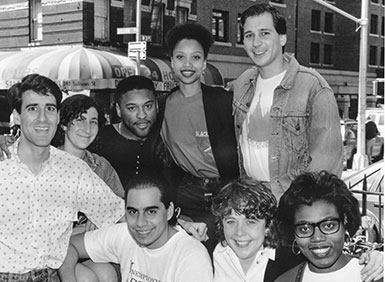
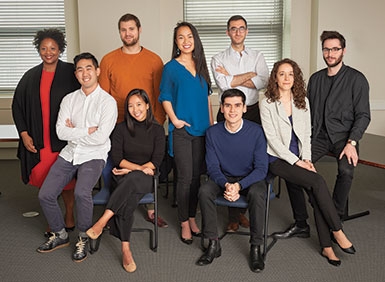
![What allows the clinical program to maintain [its] place of distinction is that our mission is unapologetically ambitious. We prepare to transform the ways that individuals and communities experience justice.](/sites/default/files/MAG19_Clinics_PQ1.jpg)
